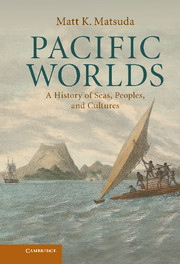Book contents
- Frontmatter
- Contents
- Illustrations
- Maps
- Acknowledgments
- Map
- Introduction: Encircling the ocean
- 1 Civilization without a center
- 2 Trading rings and tidal empires
- 3 Straits, sultans, and treasure fleets
- 4 Conquered colonies and Iberian ambitions
- 5 Island encounters and the Spanish lake
- 6 Sea changes and spice islands
- 7 Samurai, priests, and potentates
- 8 Pirates and raiders of the Eastern seas
- 9 Asia, America, and the age of the galleons
- 10 Navigators of Polynesia and paradise
- 11 Gods and sky piercers
- 12 Extremities of the Great Southern Continent
- 13 The world that Canton made
- 14 Flags, treaties, and gunboats
- 15 Migrations, plantations, and the people trade
- 16 Imperial destinies on foreign shores
- 17 Traditions of engagement and ethnography
- 18 War stories from the Pacific theater
- 19 Prophets and rebels of decolonization
- 20 Critical mass for the earth and ocean
- 21 Specters of memory, agents of development
- 22 Repairing legacies, claiming histories
- Afterword: World Heritage
- Notes
- Index
12 - Extremities of the Great Southern Continent
Published online by Cambridge University Press: 05 June 2012
- Frontmatter
- Contents
- Illustrations
- Maps
- Acknowledgments
- Map
- Introduction: Encircling the ocean
- 1 Civilization without a center
- 2 Trading rings and tidal empires
- 3 Straits, sultans, and treasure fleets
- 4 Conquered colonies and Iberian ambitions
- 5 Island encounters and the Spanish lake
- 6 Sea changes and spice islands
- 7 Samurai, priests, and potentates
- 8 Pirates and raiders of the Eastern seas
- 9 Asia, America, and the age of the galleons
- 10 Navigators of Polynesia and paradise
- 11 Gods and sky piercers
- 12 Extremities of the Great Southern Continent
- 13 The world that Canton made
- 14 Flags, treaties, and gunboats
- 15 Migrations, plantations, and the people trade
- 16 Imperial destinies on foreign shores
- 17 Traditions of engagement and ethnography
- 18 War stories from the Pacific theater
- 19 Prophets and rebels of decolonization
- 20 Critical mass for the earth and ocean
- 21 Specters of memory, agents of development
- 22 Repairing legacies, claiming histories
- Afterword: World Heritage
- Notes
- Index
Summary
In 1995, a five-million-dollar replica of James Cook's Endeavour – the famed navigator's flagship – left its moorings and sea trials in Fremantle, Australia and sailed for Sydney. An armada of small boats accompanied the ship sailing into the harbor, and a thousand spectators watched from the parapets around the opera house. As the ship docked at Man O'War Steps, the curious and enthusiastic joined the welcoming celebration.
The Endeavour replica had been commissioned in January of 1988 as a bicentenary gift to the people of Australia to celebrate the navigational feats of Captain Cook, who charted the eastern Australian seaboard for the British navy in 1770. The Endeavour gave a heroic preface to European knowledge of and interest in the island continent, leading to the first colonial settlement, epitomized by Captain Arthur Philip raising the British flag, first at Botany Bay, and shortly at Port Jackson, and claiming possession of the eastern Australian seaboard on January 26, 1788, with eleven ships and 1,350 passengers – half of them convicts – of the First Fleet. The date would come to mark Australia Day. The rest of the Fleet was mainly convicts and guards, sent now to the South Pacific after the 1776 American Revolution made the British practice of exiling prisoners across the Atlantic no longer tenable.
- Type
- Chapter
- Information
- Pacific WorldsA History of Seas, Peoples, and Cultures, pp. 161 - 175Publisher: Cambridge University PressPrint publication year: 2012



